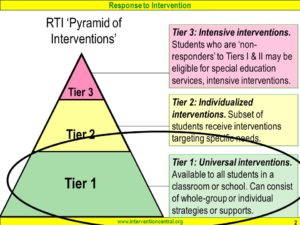We’ve all seen the pyramid for Response to Intervention. The pyramid is about the interventions needed to assist students either academically or behaviorally. The graphic shows the levels of intervention intensity and where these interventions take place. The operative word is intervention – meaning a different strategy that needs to be done to change the trajectory of the lagging skill of concern. Intervention involves data gathering and progress monitoring, not grading. Interventions are not guesses, but research-based approaches to problem-solving. The “research-based” aspect may intimidate educators into buying something, but when teachers are trained properly in research-based practices, they find they have many less costly solutions available.

Response to Intervention is NOT a referral protocol, and this must be made abundantly clear to every member of the education organization. Too many times, when a classroom teacher encounters a struggling student, the teacher’s mindset is to gather evidence of the student’s poor performance in order to refer to a specialist. When the child’s lagging skill is not just academic, but behavior also, the urge to refer is even stronger. Instead of the RTI pyramid with the wide base of classroom interventions, the pyramid becomes inverted and instead of the child experiencing success with their classroom teacher, the student may internalize the resource room pull out as a failure or different than the other students. If the child also had behavioral issues, then the relationship with the classroom teacher becomes less likely to grow.
The expectation for Response to Intervention is that the classroom teacher does not wait for failing grades, because data gathering and progress monitoring will reveal those students who are struggling early enough to intervene before failure. Having identified a need, the teacher then sets the intervention, closely monitors progress to determine if there is growth, and if not, replaces it with a new intervention until there is a measurable improvement in the lagging skill. RTI is meant to catch them early and be prescriptive to prevent failure.
What makes RTI powerful is the classroom teacher who is trained to understand and incorporate classroom interventions and research-based instructional practices that foster growth. Before adequate training, the first concern of a classroom teacher is the time required to put an intervention in place for each student with lagging skills. With all the preparation and workload related to the regular day-to-day instruction, the RTI pyramid may feel rather unrealistic and burdensome to an untrained classroom teacher. When the lagging skill is behavior-based, the energy drain on the teacher and a lack of training in effective behavioral interventions can feel like Mission:Impossible.
In my workshop – The Trauma-Sensitive, High-Achieving Classroom, I recommend and model ways classroom teachers can build-in RTI up front as part of the daily classroom routine, complete with data-gathering and progress monitoring. The techniques include activities that students do with partners, are easily part of daily routines, gives the teacher time to meet individually with students, and the students themselves gather the data on their own progress. Sounds like magic? In fact, the techniques I demonstrate are highly practical and only takes a few minutes each day. More over, once in place, it automatically becomes personalized for every child in the room. Teachers can easily modify the intervention activity to address the target skill even further. Computers are not necessary and there is nothing new to buy – office supplies and a few paper forms are all that is needed to set this up. This classroom model not only addresses academic progress but positive behavior as well because it builds positive relationships between the teacher and every student. This relationship-building is the superpower within this practice that turns the RTI Pyramid back on its intended base – the classroom.
For more, see my workshop description here. (I also do this workshop in three 3-hour sessions after school.)